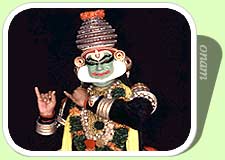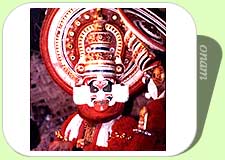Kathakali
Introduction to Kathakali
'Katha' means story and 'Kali' means dance. As the name suggests Kathakali is a beautiful amalgamation of dance and drama. More precisely, Kathakali is a harmonious blend of five forms of art namely, Sahithyam (literature), Sangeetham (music), Chithram (painting), Natyam (acting) and Nritham (dance). 'Total Theatre' is the word often used to describe this highly evolved art.
Kathakali dance-drama can also be described as a visual art because performers do not say any dialogues in this. Rather they are mime. Communication is made effective through the remarkable use of gestures and mudras. This also lends Kathakali its universal appeal. People of varied tastes all over the world appreciate and admire the beauty of this distinguished art. Another distinct feature of Kathakali is its elaborate costume and make-up. It is a magical sight to watch Kathakali artistes performing in their traditional attire. Their larger than life form transport the audience to a make believe wonderland.
Origin and Theme of Kathakali
Kathakali is one of the most renowned and revered dance-form of India. It originated in southwestern state of Kerala in the town called Travancore some 400 years ago. In a short span, Kathakali has achieved remarkable heights. Kathakali is said to have been inspired from the ancient South Indian dances like Koodiyattam, Krishnanattam, Theyyam, Kalaripayattu besides others. Movements of Kathakali are said to be adopted from Bharatha Natya Shastra with suitable modifications. The drama lends its theme from the stories in Ramayana and the Mahabharata, the famous epics of Hindu mythology. Earlier, only men were supposed to perform this considerably tough classical dance. Nowadays, even women are making a foray and carving their niche in this male dominated field.
Kathakali Music and Narration
Interestingly, there are no dialogues in Kathakali. Story narration and conversation between two characters is done mainly through the gestures made by the performers. Kathakali songs are sung in the background by vocalists, usually two in number. Kathakali lyrics are mostly in the form of verse and sung loudly by Bhagavathar (the vocalist). The unique style of singing adopted for Kathakali is called sopaanam. Kathakali music is provided by two drums known as the chenda and the maddalam. Cymbals and another percussion instrument, ela taalam are also a part of the orchestra.

Kathakali Make-up or Aharya
Most remarkable facet of Kathakali dance is its extraordinary and bewitching make-up code. It takes about 8-10 painstaking hours to carry out the elaborate Aharya, (the make-up) in all its detail. Artistes are trained to do the make-up on their own. Notably, there are various colors of make-up for the different shades of character like Pacha, Kathi, Minukku, Thadi etc.
|
|
Kathakali Costume
A massive and intricate headgear is the most important part of Kathakali costume. The headgear is prepared from light weight wood. It is embellished with mirrors, colourful stones and pieces of shiny metal plates. Layers of skirts of vivid colours are also worn for buoyancy. Loads of jewelery including anklets, bracelets, big rings and a huge chin caps complete the semblance of a Kathakali dancer. Evil characters also sport talons (big claw like nails) and beards to depict their beastly nature.
Kathakali Training
Training of a Kathakali artiste is extremely strenuous and rigorous. A performer needs to take exhaustive lessons in each and every aspect of this dance-drama. Toughest of all is the physical training which involves control of the muscles mainly that of eye balls, eye brows, eye-lids, lips, neck and shoulder. This is extremely essential part of Kathakali training as in the absence of dialogues, expressions become the most vital aspect of communication in Kathakali dance.
It is also required from the artiste that besides having a thorough knowledge of epics and mythology he must train himself in literature, both Malayalam and Sanskrit. It takes years for an artiste to attain mastery in Kathakali dance. Getting perfection in body movements, footwork and nuances of make-up is also essential. It is said that an artiste who master and synchronizes Nritta (pure dance), Nritya (expression dance), Natya (histrionics), Geeta (vocal music) and Vadya (percussion ensemble) besides literature and painting is the real Kathakali dancer.
 Kathakali Performance
Kathakali PerformanceKathakali performance begin with a musical note called Thiranottam. Before the beginning of the drama a loud thumping of drums can be heard. Most often a peaceful love scene is enacted in the beginning of the show.
Distinctiveness of Kathakali dance lies in the fact that performers do not communicate by means of words. They use the language of hand-gestures, body movements and facial expressions as means of communication. Rigorously trained, performers bring to life mythological tales with ease and e¢lan. Support of vocalist and instrumentalists also play a significant role.
Kathakali dance follows hand gestures prescribed in the book, 'Hasthalakshana Deepika'. Book contains knowledge on 24 basic mudras (hand gestures). Over 470 symbols are derived from these basic hand gestures.
To appreciate this highly evolved Indian classical dance, audience also need to have a basic understanding like background, origin of Kathakali apart from knowledge of legends and mythology.
Changing Trends in Kathakali Performance
Traditional Kathakali performances are long. Starting from the evening, a show continues for the entire night and culminates at dawn. In the modern jet age when people are tight for time, Kathakali has transformed itself. Performances are designed to last for a maximum of two hours these day.
Earlier the performance were held in the courtyards of temples or palaces of Kings of Kerala but now they are held in plush auditoriums for the convenience of the audience.
Traditional performance still take place during the time of festivals in the raised courtyards of temples at Thiruvattar, Thirparappu, Ponmana, Kuzhithurai, Neyyoor and Munchira in the Kanyakumari district.
No comments:
Post a Comment